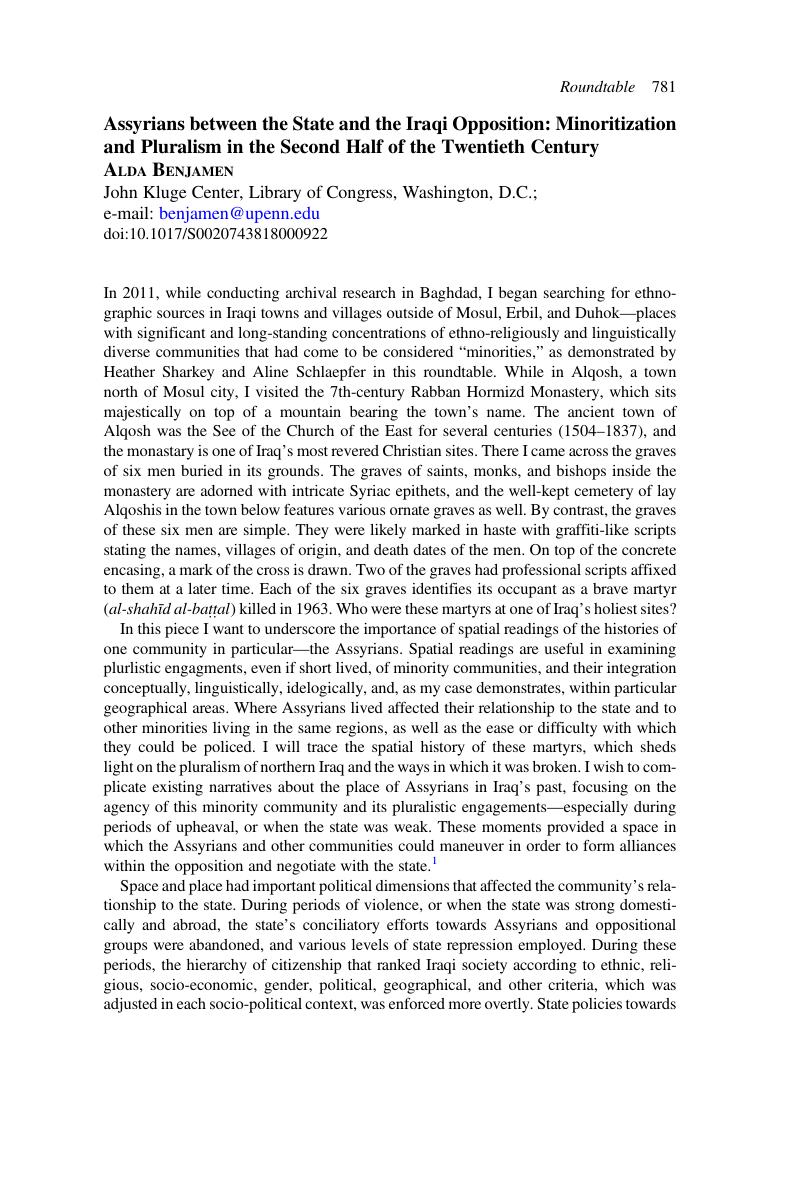Article contents
Assyrians between the State and the Iraqi Opposition: Minoritization and Pluralism in the Second Half of the Twentieth Century
Published online by Cambridge University Press: 28 November 2018
Abstract

- Type
- Roundtable
- Information
- Copyright
- Copyright © Cambridge University Press 2018
References
NOTES
1 Alda Benjamen, “Negotiating the Place of Assyrians in Modern Iraq” (PhD diss., University of Maryland, 2015).
2 Benjamen, Alda, “Assyrians and the Iraqi Communist Party: Revolution, Urbanization, and the Quest for Equality,” in Minorities and the Modern Arab World, ed. Robson, Laura (Syracuse, N.Y.: Syracuse University Press, 2016), 106–21Google Scholar. Shlimon, Arbella Bet, City of Black Gold: Oil, Ethnicity, and the Making of Modern Kirkuk (Stanford, Calif.: Stanford University Press, 2019)Google Scholar.
3 Baghdadi Assyrian intellectuals, in their magazines and clubs, used accepted narratives about socialism and Abbasidism propagated by the state, to argue for greater cultural, political, and administrative rights. This campaign was pursued subtly in the press, but more vocally in popular culture; Benjamen, “Negotiating the Place of Assyrians in Modern Iraq,” 171–214.
4 On the ways in which women exacerbated the social order, see Pursley, Sara, Familiar Futures: Time, Selfhood, and Sovereignty in Iraq (Stanford , Calif.: University Press, 2018)Google Scholar.
5 Benjamen, “Assyrians and the Iraqi Communist Party,” 106–21.
6 Rubin, Avshalom H., “Abd Al-Karim Qasim and the Kurds of Iraq: Centralization, Resistance and Revolt, 1958–63,” Middle Eastern Studies 43 (2007): 368–76CrossRefGoogle Scholar; interviews by author with informants in Barwar, Duhok city, Alqosh, and Baghdad, December 2011.
7 I.I., interviewed by author, Chicago, Illinois, 14 November 2011.
8 Y.C., interviewed by author, Chicago, Illinois, 13 November 2011. Khuyada w Kheirutha Athorayta (Assyrian Unity and Freedom) is known by its acronym, Kheith Kheith Allap II.
9 Tuma Tumas, “Awraq Tuma Tumas (3),” accessed 14 May 2014, http://www.al-nnas.com/THEKRIAT/24jsf3.htm; Tumas, “Awraq Tuma Tumas (4),” accessed 14 May 2014, http://www.al-nnas.com/THEKRIAT/30jsf4.htm. See also, al-ʿIraqi, Hizb al-Shuyuʿi, al-Hizb, Lajnat Mattbuʿ Shuhadaʾ, Shuhadaʾ al-Hizb, Shuhadaʾ al-Watan: Shuhadaʾ al-Hizb al-Shuyuʿi al-ʿIraqi, 1934–1963, 2nd ed. (n.p.: Hizb al-Shuyuʿi al-ʿIraqi, 2008), 344–46Google Scholar.
10 Tumas, “Awraq Tuma Tumas (4).” The Turkmen apparently left this force due to a split instigated by Muslih al-Jalali.
11 In these urban and politicized spaces, Assyrians were able to look beyond the sectarian divisions that had emerged within their communities in the mid-19th century. By living in shared neighborhoods, agitating in labor unions and political parties, and cooperating as intellectuals in common clubs and newspapers, they socialized outside the constraints of religious institutions. This interdenominational closeness experienced by Assyrians in the second half of the 20th century is demonstrated by the cooperation between Tumas and Chikku. In urban settings, Assyrians married across denominational lines, spoke a similar koiné of the Eastern Aramaic language, and mingled as neighbors and community members. These kinds of interactions are evident from the writings of Assyrian intellectuals during the 1970s as well. Although sectarianism emerged at various points, and especially during the 1980s, it is problematic to impose a structured analysis based solely on church affiliations that were not entirely applicable to the period under study.
12 Tuma Tumas, “Awraq Tuma Tumas (5),” accessed 14 May 2014, http://www.al-nnas.com/THEKRIAT/5jsf5.htm.
13 I.I., interview by author, Chicago, Illinois, 14 November 2011.
14 Cattel, Maria and Climo, Jacob, “Introduction: Meaning in Social Memory and History: Anthropological Perspectives,” in Social Memory and History: Anthropological Perspectives, ed. Cattel, Maria and Climo, Jacob (Walnut Creek, Calif.: Altamira, 2002), 4Google Scholar.
- 2
- Cited by




